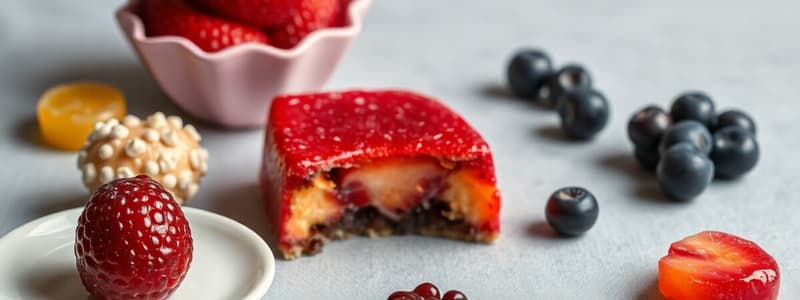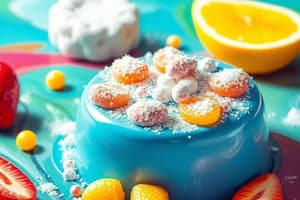Podcast
Questions and Answers
What crucial step should be taken when adding pectin to the fruit purée?
What crucial step should be taken when adding pectin to the fruit purée?
- The pectin should always be added in a slow, steady stream while whisking constantly.
- The pectin should be added with one-fourth of the sugar in the formula before adding the mixture to the purée. (correct)
- The pectin should be added as a dry powder directly into the heated purée.
- The purée should be warmed and brought to a boil before adding pectin.
What characteristic indicates that pâtes de fruits have been overcooked?
What characteristic indicates that pâtes de fruits have been overcooked?
- The candy has a slightly firm texture.
- The candy has a translucent appearance.
- The candy appears dull or cloudy. (correct)
- A slight crust forms on the outside of the candy.
What ingredient is typically used in pâtes de fruits to create a softer, more tender texture?
What ingredient is typically used in pâtes de fruits to create a softer, more tender texture?
- Gelatin (correct)
- Yellow pectin
- An acid
- Glucose
What is the recommended temperature for adding the pectin-sugar blend to the fruit purée?
What is the recommended temperature for adding the pectin-sugar blend to the fruit purée?
Which of the following is NOT a characteristic of properly made pâtes de fruits?
Which of the following is NOT a characteristic of properly made pâtes de fruits?
When making pâtes de fruits, why is it crucial to whisk the preparation continuously after adding the pectin?
When making pâtes de fruits, why is it crucial to whisk the preparation continuously after adding the pectin?
What is the primary reason for using a slow, steady stream when adding the pectin-sugar blend to the fruit purée?
What is the primary reason for using a slow, steady stream when adding the pectin-sugar blend to the fruit purée?
What should be considered when substituting commercially available frozen fruit purees for pâtes de fruits formulas?
What should be considered when substituting commercially available frozen fruit purees for pâtes de fruits formulas?
What is the primary reason for adding acid to the pâte de fruit mixture?
What is the primary reason for adding acid to the pâte de fruit mixture?
Which of the following is NOT a reason to cover the pâte de fruit with plastic after depositing?
Which of the following is NOT a reason to cover the pâte de fruit with plastic after depositing?
What is the ideal surface for depositing pâte de fruit, and why?
What is the ideal surface for depositing pâte de fruit, and why?
What is the main purpose of using a guitar to cut pâte de fruit?
What is the main purpose of using a guitar to cut pâte de fruit?
Why is it essential to cook the pâte de fruit to the specific temperature listed in the recipe?
Why is it essential to cook the pâte de fruit to the specific temperature listed in the recipe?
What is the Brix scale used to measure?
What is the Brix scale used to measure?
What is the primary reason for coating the cut pâte de fruit in granulated sugar?
What is the primary reason for coating the cut pâte de fruit in granulated sugar?
What happens if the pâte de fruit is undercooked?
What happens if the pâte de fruit is undercooked?
What is the recommended drying time for pâte de fruit after it has been coated in sugar?
What is the recommended drying time for pâte de fruit after it has been coated in sugar?
Why should the parchment paper used for drying the pâte de fruit be dusted with granulated sugar?
Why should the parchment paper used for drying the pâte de fruit be dusted with granulated sugar?
Flashcards
Pâtes de fruits
Pâtes de fruits
A French confection made from fruit puree, sugar, pectin, and acids.
Ingredients
Ingredients
Made from fruit juice, sugar, glucose, pectin, and acid.
Texture
Texture
Should be firm yet tender, never too soft.
Appearance
Appearance
Signup and view all the flashcards
Sugar concentration
Sugar concentration
Signup and view all the flashcards
Pectin prep
Pectin prep
Signup and view all the flashcards
Cooking process
Cooking process
Signup and view all the flashcards
Variations
Variations
Signup and view all the flashcards
Temperature Increase in Pâtes de Fruits
Temperature Increase in Pâtes de Fruits
Signup and view all the flashcards
Gelling Process
Gelling Process
Signup and view all the flashcards
Ideal Depositing Surface
Ideal Depositing Surface
Signup and view all the flashcards
Layered Pâte de Fruit
Layered Pâte de Fruit
Signup and view all the flashcards
Temperature and Texture
Temperature and Texture
Signup and view all the flashcards
Brix Scale
Brix Scale
Signup and view all the flashcards
Refractometer
Refractometer
Signup and view all the flashcards
Guitar Cutting Tool
Guitar Cutting Tool
Signup and view all the flashcards
Dredging Process
Dredging Process
Signup and view all the flashcards
Drying Time
Drying Time
Signup and view all the flashcards
Study Notes
Pâtes de Fruits Confection
- Pâtes de fruits are French fruit candies made from fruit juice/puree, sugar, glucose, pectin, and acid.
- Formulas may include gelatin, leading to a softer texture.
- Texture should be firm yet tender, with a slight shine and a thin sugar crust.
- Can be opaque or translucent, depending on the fruit.
- Variations include multi-layer flavors or layering with ganache or praline.
- Enrobing in chocolate is necessary when using ganache.
Ingredients & Formulas
- Formulas are often found via frozen fruit puree purveyors.
- Typical purees include 10% added sugar.
- Formulas account for sugar percentages in the puree.
- A chart of formulas using commercially available frozen fruit purees is included.
Cooking Process
- Process is simple; however, precise temperature control is key.
- Incorrect temperature leads to tough or incompletely set products.
- Constant whisking is important after pectin addition to evaporate liquid.
- Faster cooking is preferred over slower methods.
Initial Steps
- Puree is warmed to a boil.
- One-fourth of the sugar is combined with pectin.
- This crucial step prevents pectin clumping.
- When the puree reaches 122°F (50°C), the pectin-sugar mixture is added gradually.
Adding Sugar & Other Ingredients
- Remaining sugar is added in three stages, slowly and steadily, while maintaining temperature.
- Glucose is added after all sugar.
- The mixture continues to cook until the target temperature is reached.
- Acid is added at the very end, thoroughly mixed, and deposited immediately. This activates the gelling process.
Depositing & Setting
- Silicone molds (shallow-sided) are ideal for depositing.
- Silicone mats and metal/frame alternatives are usable.
- Depositing should be done swiftly and smoothly on a granite flat surface to avoid warping.
- Ensure the surface is flat and solid.
- Pâtes de fruits are firm yet warm 20 minutes after depositing.
- Cover with plastic to prevent drying and promote sugar sticking.
Layered Pâtes
- Crucial to cover first layer (sticky and warm) when pouring the second layer.
Quality & Temperature
- Precise cooking temperature guarantees correct solid/liquid concentration.
- Overcooked pâtes de fruits are dry, tough, and lack brilliance.
- Undercooked pâtes de fruits are watery and may not set.
- Brix scale (sugar density) can be measured using a refractometer.
Storage & Finishing
- Pâtes de fruits are stored in the freezer or used immediately as part of mise en place.
- Cutting in squares.
- Guitar tool is used for evenly cutting confections.
- Cut pieces are coated in granulated sugar and left covered for at least 24 hours.
- Excess sugar is shaken off.
- Dried on a sheet pan lined with parchment paper dusted lightly with sugar for at least 24 hours to allow crust formation.
- Candies can later be packaged or stored in plastic.
Summary of Process
- Scale ingredients, warm puree, blend pectin with sugar.
- Add sugar pectin to heated puree.
- Add remaining sugar and glucose to the boiling mixture.
- Add acid, deposit.
- Dredge in sugar, cut.
- Submerge in sugar, shake off excess sugar.
- Place on sheet pan, dry for 24 hours.
- Flip and dry for another 24 hrs
- Package or store.
Studying That Suits You
Use AI to generate personalized quizzes and flashcards to suit your learning preferences.




